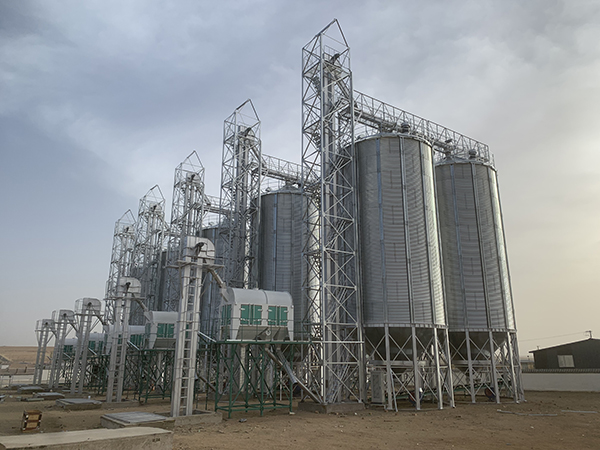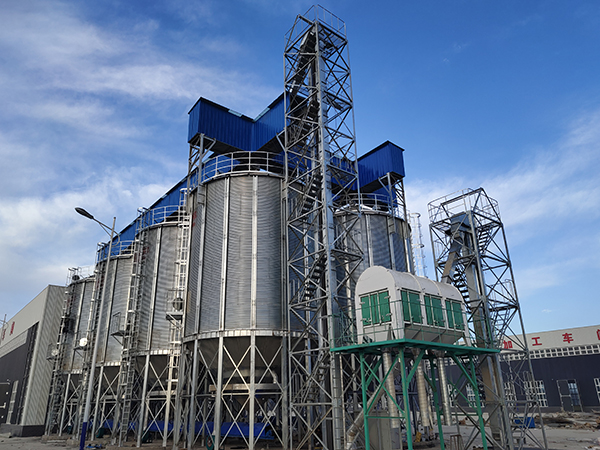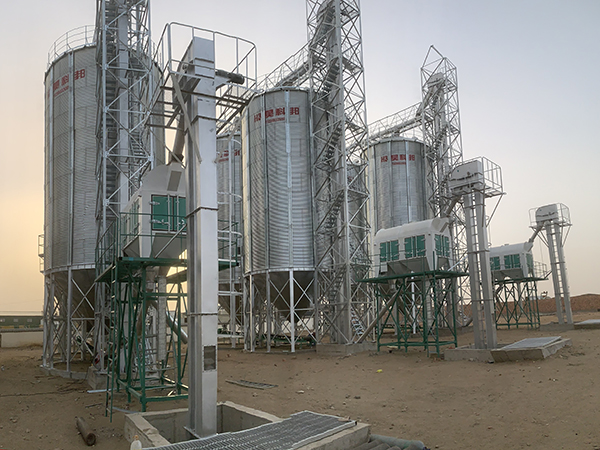wheat seed silo
A wheat seed silo is a specialized agricultural facility designed for the storage of wheat seeds. Its design and construction aim to ensure
wheat seed silo Introduction
A wheat seed silo is a specialized agricultural facility designed for the storage of wheat seeds. Its design and construction aim to ensure the quality and viability of the wheat seeds during storage, so they can be used effectively in future planting seasons.


Wheat seed silo features
Sealing
Good sealing performance prevents moisture, pests, and other factors that could damage the seed quality from entering the silo.
Ventilation System
To ensure the freshness and vitality of the seeds, there must be good air circulation within the silo to prevent the seeds from molding or germinating.
Temperature and Humidity Control
By regulating the temperature and humidity inside the silo, the storage life of the seeds can be effectively extended, and their germination rate can be maintained.
Capacity
The size of the silo can be designed according to storage needs, making it suitable for farms of all sizes and seed companies to choose the appropriate scale.
Manageability
Modern wheat seed silos are often equipped with monitoring systems that can monitor the status of the seeds in real-time and predict the storage conditions through data analysis.
Pest and Rodent Protection
The design and material selection of the silo must consider preventing pests and rodents from entering to protect the seeds from damage.
Ease of Loading and Unloading
The structural design of the silo should facilitate the loading and unloading of seeds, reducing the difficulty and time required for manual operations, and improving efficiency.
The construction and management of wheat seed silos are of great significance to agricultural production. They not only ensure the quality and quantity of seeds but also provide a stable supply of seeds for agricultural production, thereby ensuring food security and sustainable agricultural development.


Wheat seed silo structure
Silo Structure
This forms the main body of the silo, typically constructed from durable materials such as metal or concrete to ensure strength and longevity. The design of the silo structure takes into account factors like storage capacity, sealing, ventilation, and ease of cleaning.
Base Structure
The base structure includes the foundation and support system for the silo, providing stable support and ensuring that the silo can bear the weight of the stored seeds.
Ventilation System
To maintain the dryness and freshness of the seeds, a ventilation system is essential. It usually comprises ducts, fans, and vents to ensure free air circulation within the silo.
Loading and Unloading System
This includes equipment and machinery used for loading and unloading wheat seeds, such as conveyor belts, elevators, and screw conveyors. These devices make the process of moving seeds in and out quick and convenient.
Temperature and Humidity Control System
To maintain the optimal environment inside the silo, a temperature and humidity control system is typically installed, featuring heaters, coolers, and humidity regulators, among other devices.
Monitoring and Control System
Modern wheat seed silos are often equipped with advanced monitoring and control systems that continuously monitor environmental parameters within the silo, such as temperature, humidity, and gas concentrations, and can automatically adjust according to preset parameters.
Safety System
This includes fire protection systems, pest and rodent control facilities, and other measures to ensure the safety of the silo interior and the quality of the seeds.
Cleaning System
To maintain the hygiene within the silo, a cleaning system is in place for regular cleaning, preventing contamination and the breeding of pests.
Operating Platforms and Passageways
To facilitate the daily management and maintenance by operators, operating platforms and safe passageways are typically set up around the silo.
These components work together to ensure that wheat seed silos effectively protect the seeds, extend their lifespan, and provide a stable and reliable supply of seeds for agricultural production.


Wheat seed silo advantages
Enhanced Seed Quality
By controlling the temperature, humidity, and ventilation within the silo, the vitality and quality of wheat seeds are effectively maintained, reducing degradation caused by environmental factors.
Extended Seed Lifespan
Good storage conditions and environmental control can significantly extend the lifespan of wheat seeds, keeping them viable for planting over a longer period with an appropriate germination rate and growth potential.
Prevention of Seed Contamination
The design of the silo effectively shields the seeds from external contaminants such as pests, rodents, and microorganisms, protecting the seeds from damage.
Improved Storage Efficiency
The structural design of the silo makes the loading, unloading, and handling of seeds more efficient, reducing labor costs and time consumption.
Facilitated Management and Monitoring
Modern wheat seed silos are often equipped with automated monitoring and control systems, allowing management personnel to easily monitor the environment and seed status within the silo, identifying and addressing issues promptly.
Space Saving
The vertical design of the silo allows for efficient use of space, enabling the storage of a larger quantity of seeds on limited land.
Reduced Losses
By minimizing losses and waste during the storage process, silos contribute to improved economic benefits in agricultural production.
Adaptability
Wheat seed silos can be designed and adjusted according to different geographical environments and climatic conditions, demonstrating strong adaptability.
Food Security Assurance
By ensuring the quality and supply of seeds, wheat seed silos provide a stable source of seeds for agricultural production, aiding in the safeguarding of food security and sustainable agricultural development.
Environmental Protection
By managing and storing seeds in a centralized manner, silos help reduce the environmental impact of agricultural production, promoting green agricultural development.
In summary, wheat seed silos have significant advantages in enhancing seed quality, extending seed lifespan, preventing contamination, improving storage efficiency, facilitating management, saving space, reducing losses, assuring food security, and protecting the environment.
Application scope of Wheat seed silo
Coban Silo is widely used for grain storage such as wheat, corn, soybean, paddy, rice, soybean meal, barley, malt, sunflower seeds, rapeseed, peanuts, flour, and other powder materials, oat, special Silo, and seeds, etc.

Wheat seed silo technical parameters
Scientifically speaking, the Silo capacity should be measured with volume (m3). Even in the same grain Silo, the storage tons will be different for different grains with different densities. The following table is calculated based on a Silo density of 0.75kg/m3, and surely HKB customizes Silo systems unique for you.
| Most Popular Hopper Bottom Steel Silo Technical Specifications | ||||||||
| Capacity | 50Ton | 100Ton | 150Ton | 200Ton | 300Ton | 500Ton | 1000Ton | 1500Ton |
| Model | TCZK
03605 |
TCZK
04507 |
TCZK
05507 |
TCZK
06406 |
TCZK
07307 |
TCZK
07313 |
TCZK
11010 |
TCZK
12811 |
| Diameter(m) | 3.667 | 4.584 | 5.500 | 6.417 | 7.334 | 7.334 | 11.000 | 12.834 |
| Total Height(m) | 9.56 | 12.53 | 13.25 | 12.85 | 14.70 | 21.42 | 20.95 | 23.51 |
| Volume(m³)
Density:0.75ton/m³ |
69 | 150 | 222 | 273 | 415 | 699 | 1346 | 2039 |
| Most Popular Flat Bottom Steel Silo Technical Specifications | ||||||||
| Capacity | 1000Ton | 1500Ton | 2000Ton | 2500Ton | 3000Ton | 5000Ton | 8000Ton | 10000Ton |
| Model | TCK
10014 |
TCK
11915 |
TCK
13715 |
TCK
15514 |
TCK
15518 |
TCK
18321 |
TCK
24718 |
TCK
25621 |
| Diameter(m) | 10.084 | 11.918 | 13.750 | 15.584 | 15.584 | 18.334 | 24.751 | 25.668 |
| Total Height(m) | 18.69 | 20.34 | 20.87 | 20.30 | 24.78 | 28.60 | 26.99 | 30.60 |
| Volume(m³)
Density: 0.75ton/m³ |
1335 | 2009 | 2701 | 2467 | 4145 | 6693 | 10879 | 13484 |








